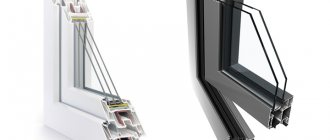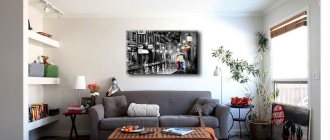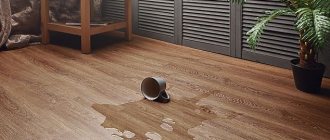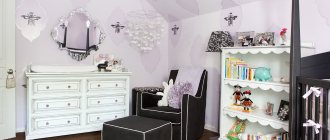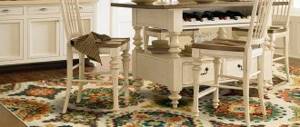Choosing linoleum depending on the room
Before making a choice of linoleum, it is worth understanding its classification. In the European classification (with which domestic manufacturers also work), the first digit of the marking indicates the type of room.
| The first digit of the class marking | What type of linoleum corresponds |
| 1 | Linoleum for rooms with minimal traffic |
| 2 | Linoleum for apartments |
| 3 | Linoleum for office premises |
| 4 | Linoleum for industrial premises |
The following number indicates the load linoleum can withstand:
| Number | Load type |
| 1 | Light load |
| 2 | Average load |
| 3 | High load |
| 4 | Very high load (highest coating strength) |
In addition, Europeans have developed drawings that are placed on rolls of linoleum to make it easier for buyers to understand the classes of linoleum.
Depending on the type of load, linoleum is divided into several types depending on the thickness of the protective layer.
| Type of linoleum | Thickness of the protective layer, mm |
| Household linoleum | 0,35 |
| Semi-commercial | 0,35-0,6 |
| Commercial | more than 0.6 |
You can read more about the types of linoleum on our website.
The nuances of laying linoleum in the kitchen
Installation consists of the following steps:
- Preparing the floor, removing dirt and dust;
- Surface leveling;
- Placement of linoleum. Leave it for a while to straighten out;
- Trimming according to room size;
- Fixing the coating;
- The installation is completed by installing the baseboard.
There are installation nuances that are related to the floor material. Wooden bases require leveling with special slabs. A self-leveling screed is required for a concrete floor.
Compared to laminate and tiles, linoleum is a better option for the kitchen.
Which linoleum is better for an apartment
The flooring in each room experiences different loads depending on the function of the room. Next, we will look at which linoleum is more suitable for certain rooms in the apartment.
The right choice of linoleum for the kitchen and corridor
The kitchen and hallway have the highest traffic in the apartment, so it is worth using semi-commercial linoleum with a thickness of at least 3 mm. For these rooms, the thickness of the protective layer of linoleum is important - if the coating is thin, the linoleum will have to be changed soon.
From a design point of view, the traditional solution for the kitchen is linoleum, imitating ceramic tiles. For more information about kitchen design, read the article on how to choose linoleum for the kitchen.
Linoleum for the living room
In the living room there is an average degree of load on the linoleum. Here you can use household PVC-based linoleum or semi-commercial linoleum.
Linoleum for the bedroom
In the bedroom, traffic is much lower, so thinner household linoleum with a thickness of 1.5 mm can be used here.
Linoleum for children's rooms
In a children's room there is a high risk of mechanical damage to the floor covering, so it is worth laying household linoleum on a foam base or semi-commercial linoleum here.
Advice! You should also remember about the environmental friendliness of the coating: experts advise using natural linoleum in children's rooms. Firstly, it does not emit chemicals, and secondly, it has bactericidal properties.
How to choose linoleum?
Selection tips:
- In a room located on the shady side, it is better to use linoleum covering in light and pastel colors, and when decorating a room with a southern orientation, products in cooler shades.
- To visually expand a narrow room, you can use material with a linear pattern located across the walls or diagonally.
- Also, linoleum with a small tiled pattern is perfect for visually enlarging a small space.
Choosing a substrate for linoleum
Before laying linoleum, you should think about the substrate. The underlay is a heat and sound insulating material that is placed under linoleum or laminate. In addition, it smoothes out floor defects. There are several types of substrate:
- Cork
- Jute
- Linen
- Foamed
Cork backing for linoleum
Cork backing is made from crushed tree bark, without the use of synthetic products. The material is well suited for heat and sound insulation. However, one should take into account the fact that the cork backing is deformed under heavy pieces of furniture.
Jute backing for linoleum
Jute backing is made from natural fibers. During production, the jute substrate undergoes special treatment, making it resistant to fire or mold.
Linen backing for linoleum
Linen backing, like jute, is made from natural fiber. This material is good because it maintains ventilation between the floor and linoleum.
Foamed backing for linoleum
Experts do not recommend using this type of substrate, as it quickly loses its shape and does not perform its functions.
Today, experts agree that a backing for linoleum is, in principle, not particularly necessary. The only exception is the use of a substrate when choosing baseless linoleum. And all other types of linoleum are made on a jute, fabric or polyvinyl chloride base, so there is no need for an additional base.
Features of light linoleum
In addition to the fact that light linoleum increases space, there are several other features that distinguish it from dark linoleum.
For example, if you are using glossy linoleum, then know that light will be reflected from the surface of such a floor. And the room will seem not only larger, but also much lighter.
Light linoleum looks good if combined with dark furniture. Such an interior will acquire elegance and nobility. And it all looks very elegant.
In general, light material fits perfectly into any interior style. It doesn't matter what design direction you decide to implement in your home. Linoleum is available in such a variety of colors and patterns that it will not be difficult to choose the right option for both a classic interior and a high-tech interior.
Linoleum or laminate?
Laminate is a covering of 4 layers, linoleum consists of 6 layers.
Below we propose to compare laminate and linoleum according to several parameters.
Price of laminate and linoleum
If we talk about the price of floor coverings, then semi-commercial and commercial types of linoleum cost from 80 UAH per square meter, and a square meter of laminate - from 140 UAH and above.
Durability and environmental friendliness of floor coverings
Laminate is a more durable coating than linoleum and can withstand heavy loads. In addition, laminate is a more environmentally friendly coating and does not cause allergies.
Duration and quality of use of laminate and linoleum
If we compare the durability of the coating, then it all depends on the price and class. If a cheap laminate will last you 5 years, then linoleum will last at least 10 years. But if you buy a high-class laminate, then no linoleum can compare with it.
Linoleum provides better heat and sound insulation. To insulate the floor when laying laminate, you need to use a special underlay (at an additional cost).
Caring for laminate and linoleum
When it comes to caring for floor coverings, both linoleum and laminate are quite unpretentious. Just keep in mind that a large amount of water can seriously damage the laminate, so we do not recommend using it in the kitchen.
In general, both coatings have their advantages and disadvantages, so when choosing a coating for your apartment, consider which characteristics are of highest priority to you.
Practical recommendations
To visually increase the area of the room, purchase a covering with a diagonal pattern. If you need to cover the floor with high-quality flooring, pay attention to Tarquette linoleum in the interior.
The floor, door panels and furniture must match in color, be in warm or cold colors, without mixing. If the doors are lighter, then the plinth, as a unifying element, should have a color similar to the doors. With dark doors, the baseboard can match the color of the linoleum, both in the photo and the door panels.
To summarize, we note that linoleum is an excellent option for creating a durable, reliable and long-lasting coating. This material is equally suitable for the bedroom, living room, kitchen, nursery, hallway. Thanks to the variety of colors and range of design solutions, linoleum has become a universal coating. It is easy to care for and is hypoallergenic. That is why it is easy to organize the interior of your dreams using this material.
Tips for buying linoleum
Some tips for those who decide to buy linoleum for their apartment:
- Never bend or fold linoleum in half. Roll it up with the right side facing inward.
- Do not choose linoleum without a protective coating - this is a condition for the durability and cleanliness of the coating.
- Do not purchase linoleum from two different deliveries, because the color of the coating may be slightly different.
We hope our article will help you make the right choice!
Perhaps we missed something in the article, so you can also watch a video on how to choose linoleum.
Types of linoleum for flooring
Based on thickness, susceptibility to abrasion and the presence of a protective layer, coatings are divided into three main classes:
- Commercial. It is made of polyvinyl chloride and most often has a single-layer structure without additional backing. The commercial type is hygienic, fire-resistant and has a powerful protective layer that can significantly increase the strength and durability of the product.
- Semi-commercial. It is considered quite wear-resistant. It consists of a felt and synthetic base, due to which this coating better retains heat in the room.
- Domestic. Universal, moisture-resistant, elastic, easy to care for, comes in a wide range of colors and has a foam and felt base.
The photo shows semi-commercial blue linoleum on the floor in the kitchen interior.


